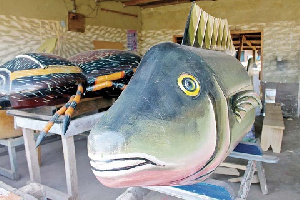Opinions of Sunday, 27 March 2016
Columnist: philly.com
Personal journey: Coffins of Ghana
I was passing through Ghana, well, not exactly. See, I found myself passing through Africa, and I made a detour through Accra because I had become transfixed by stories I had heard of the coffins.
There's this thing about the coffins in Ghana. The subject of death is uncomfortable - that is, to some people. But as an artist and storyteller, I've been fascinated with it since childhood. It is an adventure to a place I cannot see, touch, draw, or photograph. It is unconquered, unfathomable, unrecorded - I want to know what it is.
The thought of it is terrifyingly liberating.
In Ghana, three subjects for which I've a penchant - art, death, and storytelling - converged in the workshop of one man, Eric Adjetey Anan, the craftsman who makes death beautiful, colorful, and, at times, whimsical, with his hand-crafted wood coffins. He allows death be as human as life. I longed to capture this space and time with my lens, to see and know it in its moment, the craftsmen in their movements and the vessels in process.
I ventured from the airport, along the coast, semi-conscious, still picking nettles from my thighs - having emerged from a gorilla preserve in Rwanda less than 24 hours before. Tearing at flea bites from camping in the Serengeti, having learned that one can have too much of anything - even me - even if that thing is adrenaline.
The coffin itself was a visual representation of a part of the person's life and the vehicle through which he would travel to the next adventure - death.
This was striking - death of the human - the vehicle through which the human travels to the next portion of this journey.
You can watch films about Anan; he is something of a celebrity. He's a kind soul, warm eyes, deep voice, and hands of a craftsman. He was welcoming and warm. He was glad to tell me his story and share his workspace with me.
Shortly into our conversation, we realized we had common ground in having disappointed our parents with our chosen paths. I, a woman, wandering well off the beaten path with my camera and my Ivy League education as an artist; he, choosing a craft to work with his hands in spite of his parents' wishes for him to pursue a path that did not involve working with his hands. We had both chosen to walk alive and breathing - upright - until our coffins were ready for us.
One doesn't feel strange in a foreign place when the paths of the soul converge in such similar ways and when mutual respect for life's work and realization can be found. What we create does this, whether it be art, music, or our crafts. It brings us together; we see into one another. We find one another's stories and truths. We know what the other is about without having to ask precisely the ins and outs. What we create makes us alive.
We find this common ground through what we create with love. Hopefully, we discover that within our lifetime.
The coffins of Ghana take their passengers to the next phase of existence in an aesthetic representation of something that was significant in their lives: a visual emblem, colors, textures, three dimensions.
A capsule embodying them in the body they've left - representing an image that touched them, something that grasped their heart or mind - whether it be an insect, a camera, or a hammer. All of which are relevant, as they are, like the sounds we love or the flavors we taste, or the love we make - sensory moments that make up the intricate fabric of our perception of this reality, that create our story.
Needless to say, I stood out in Ghana as a woman, almost 6 feet tall, sturdy-framed, strawberry-haired, freckles. I stand out everywhere - let's face it. Traveling off the beaten path makes one rather skilled at exhibiting a certain grace during discomfort, which is probably why Vikings always look so good.
You reach a certain point, with enough adventures under your belt, where being too comfortable becomes uncomfortable and you're left with the restlessness of never being satisfied. Or, perhaps, that's just part of being an artist.
Entertainment










